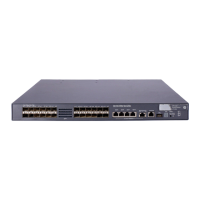24
To do… Use the command… Remarks
6. Configure the size of the data
field in each UDP packet.
data-size size
Optional.
100 bytes by default.
7. Configure the string to be
filled in the data field of each
UDP packet.
data-fill string
Optional.
By default, the string is the
hexadecimal number
00010203040506070809.
8. Specify the source port of UDP
packets.
source port port-number
Optional.
By default, no source port number
is specified.
9. Configure the source IP
address of UDP packets.
source ip ip-address
Optional.
By default, no source IP address is
specified.
The source IP address must be that
of an interface on the device and
the interface must be up;
otherwise, no probe packets can
be sent out.
10. Configure optional
parameters.
See “Configuring optional
parameters for an NQA test
group”
Optional.
Configuring voice tests
Voice tests of an NQA test group are used to test VoIP network status, and collect VoIP network
parameters so that users can adjust the network.
NOTE:
Do not perform voice tests on known ports, ports from 1 to 1023. Otherwise, the NQA test might fail
or
the corresponding services of these ports might be unavailable.
A voice test takes the following procedure:
1. The source (NQA client) sends voice packets of G.711 A-law, G.711 μ-law or G.729 A-law codec
type at regular intervals to the destination (NQA server).
2. The destination affixes a time stamp to each voice packet that it receives and then sends it back to
the source.
3. Upon receiving the packet, the source calculates results, such as the delay jitter and one-way delay
based on the packet time stamps. The statistics reflect network performance.
Voice test result also includes the following parameters that reflect VoIP network performance:
• ICPIF—Measures impairment to voice quality in a VoIP network. It is decided by packet loss and
delay. A higher value represents a lower service quality.
• MOS—Value can be evaluated by using the ICPIF value, ranging from 1 to 5. A higher value
represents a higher quality of a VoIP network.
The evaluation of voice quality depends on users’ tolerance to voice quality, which should be taken into
consideration. For users with higher tolerance to voice quality, use the advantage-factor command to

